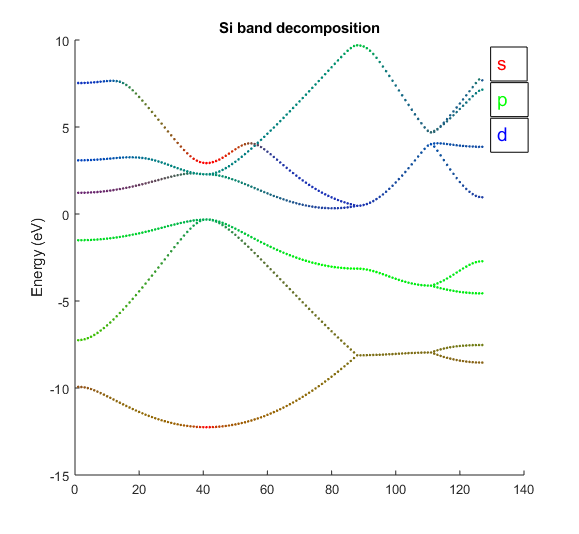4.5. Band structure decomposition

Fig. 4.5.1 Silicon band structure colored according to their \(s\), \(p\), \(d\) character.
Band structure decomposition is a useful tool to analyze a system’s
spectrum, whereby each eigenstate is decomposed into atomic orbital
components, giving rise to as many partial weights as there are atomic
orbitals. One may then know, for example, if a band is more strongly
\(s\) or \(p_z\) in character. The band decomposition can be
calculated and saved by setting the keyword
option.savePartialWeights to true. Define the input file
si_real_bs_pw as follows
info.calculationType = 'band-structure'
info.savepath = './results/si_real_bs_pw';
kpoint.type = 'line';
kpoint.gridn = 32;
kpoint.sympoints = {'L','G','X','W','K'};
rho.in = './results/si_real_scf';
option.savePartialWeights = true
and pass it to RESCU
rescu -i si_real_bs_pw
The partial weights for every band, k-point and spin are stored in the
HDF5 file ./results/si_real_bs_pw.h5. They can be loaded as follows
h5path = './results/si_real_bs_pw.h5';
wii = loadDistArray(h5path,'/LCAO/partialWeight1');
where wii is a \(n_{nao}\times n_{bnd}\) matrix. The orbital
information for each row is stored in LCAO.orbInfo in
./results/si_real_bs_pw.mat. If the data is not too large, it will
also be saved to a text file named DecomposedBandStructure.txt. The
format is the same as that of BandStructure.txt, but there are
additional blocks containing the atomic orbital weights. For each
k-point and spin degrees of freedom, one will find the
\(n_{nao}\times n_{bnd}\) matrix of partial weights. The order is as
follows \({k_1^1,...,k_{n_k}^1,k_1^2,...,k_{n_k}^{n_s}}\); the
k-points come in order and there are two sets of blocks if spin is
included. In Fig. 4.5.1, the
color of each marker is defined using RGB proportional to the
\(s\)-, \(p\)- and \(d\)-orbital character respectively.
Such figures can be generated using a script such as
examples/weightedBS. Note that the partial weights may be negative
because the atomic orbital basis is generally not orthogonal, and the
sum of the weights may not be equal to one since the atomic orbital
basis is not complete (unless the calculation was performed from LCAO).